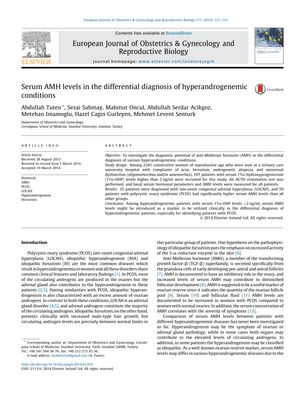Serum AMH Levels in the Differential Diagnosis of Hyperandrogenemic Conditions
June 2014
in “
European Journal of Obstetrics & Gynecology and Reproductive Biology
”
hyperandrogenemia 17α-OHP LOCAH PCOS serum AMH levels TSH FSH E2 total testosterone 1-4-androstenedione LH LH/FSH ratio DHEAS IHA IH 17α-hydroxyprogesterone late-onset congenital adrenal hyperplasia polycystic ovary syndrome anti-Müllerian hormone thyroid-stimulating hormone follicle-stimulating hormone estradiol testosterone androstenedione luteinizing hormone dehydroepiandrosterone sulfate idiopathic hirsutism idiopathic hyperandrogenism

TLDR Blood AMH levels are higher in women with PCOS than in those with other similar conditions.
In a study of 2241 women with hyperandrogenemia symptoms, 107 with elevated 17α-OHP levels were further analyzed, leading to 25 diagnoses of LOCAH and 59 of PCOS. The study concluded that serum AMH levels were significantly higher in patients with PCOS compared to those with other hyperandrogenemic conditions such as LOCAH, IHA, and IH. While no significant differences were found in serum TSH, FSH, E2, 17α-OHP, total testosterone, and 1-4-androstenedione levels among the groups, LH levels and the LH/FSH ratio were higher in PCOS patients, and DHEAS levels were significantly higher in the IHA group, except when compared to the LOCAH group. The study suggests that serum AMH levels could be a useful marker for diagnosing PCOS, despite limitations like its partially retrospective design and the small number of patients analyzed.






